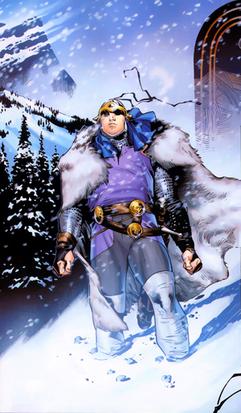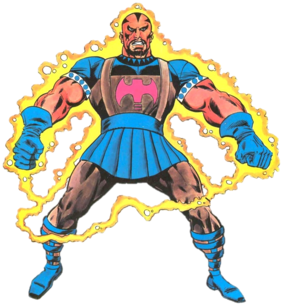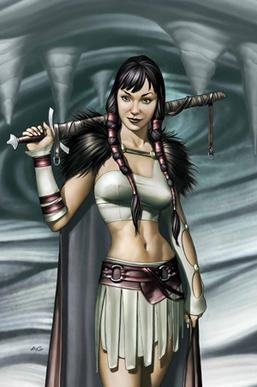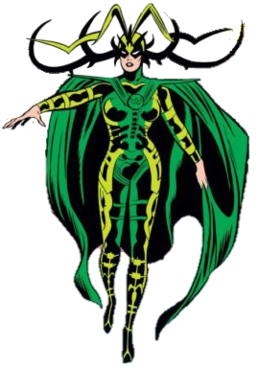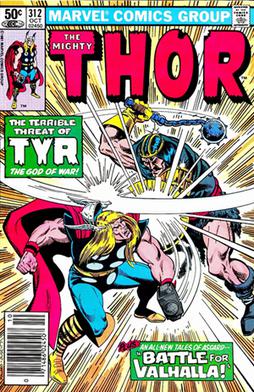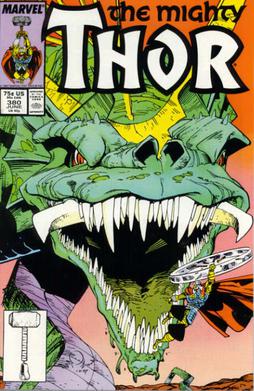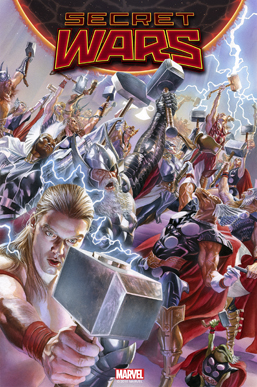Fictional history
According to Asgardian legend, in the beginning there was nothing, but in time two worlds came into being on opposite sides of the void. The one to the north was named Niflheim, a world of clouds and shadows in whose center surged the fountain Hvergelmir, from which flowed twelve rivers of ice. The one to the south was named Muspelheim, which teemed with rivers of fire. Eventually the warm air from the south carved out the ice giant Ymir from the ice in the north. Ymir became the father of all the giants, and his cow Auðumbla licked out of the ice the first Asgardian, Buri. Buri had a son named Borr, who married the giantess Bestla. Borr and Bestla had three sons named Odin, Vili, and Ve, who were known as the Æsir. Odin and his brothers grew to hate the giants and slew Ymir, and his blood formed a great sea. Odin and his brothers then raised Ymir's body from the sea and created Midgard between Niflheim and Muspelheim. With Ymir's bones they created mountains, and with his hair they created trees. They then raised Ymir's skull upon four pillars to create the heavens. Within the skull contained sparks from Muspelheim, which became the sun, moon, and stars. When Midgard was complete, Odin and his brothers created a home for themselves above it called Asgard. Between the two worlds they stretched a rainbow bridge and called it Bifröst. [3]
Once a year Odin must undertake the Odinsleep to regain his strength. During this time Asgard is vulnerable to attack from its many enemies, most notably Odin's adopted son, Loki. Loki first takes command of Asgard during the Odinsleep, using his right as the 'son' of Odin before Thor could claim it, but fled when Asgard was invaded by Mangog as he realized that this new foe was too powerful. [4] Loki later usurped the throne of Asgard by taking the Odinring, but fled again when Asgard was invaded by the fire demon, Surtur. [5]
The throne of Asgard later passes to Thor after Odin is killed in battle by Surtur, when the demon invades Earth. [6]
It was prophesied that Loki would lead Asgard's enemies in a final conflict known as Ragnarök, which would lead to its destruction. This comes to pass when Loki obtains the forge that created Mjolnir and creates new uru hammers for his army. The entirety of Asgard and its inhabitants are destroyed in the resulting battle. [7]
After Ragnarök, Donald Blake awakens Thor from the "Void of Non-Existence". Thor returns to Earth and rebuilds Asgard outside of Broxton, Oklahoma, purchasing the land with gold from the treasury. Thor then goes about restoring the Asgardians, who have been reborn in the bodies of mortal men and women. [8]
Asgard's location on Earth makes the city a target during the "Secret Invasion" by the Skrulls led by a Super-Skrull named Godkiller, whose powers mimic Thundra, Titania, Volcana and Battleaxe. The aliens are repelled with help from Thor's ally, Beta Ray Bill. [9]
When Thor is forced to abdicate the throne and is exiled for killing his grandfather Bor, who was brought from the past and driven mad by Loki, control of Asgard passes to Thor's half-brother, Balder. [10]
Asgard is destroyed yet again after Norman Osborn seizes control of S.H.I.E.L.D. following the Secret Invasion as he seeks to expel Asgard from U.S. soil in an effort to consolidate power. Osborn leads the Dark Avengers in the Siege of Asgard. The invading forces are defeated with help from the reunited Avengers, although Asgard itself is toppled by the Sentry. Immediately following the Siege, Thor reerects Heimdall's observatory atop Stark Tower as sign of solidarity with Midgard and appreciation for the Avengers' aid. [11]
Thor restores Odin to the throne when the nine realms are invaded by "the World Eaters". [12] However, after Thor and Odin's long-forgotten brother Cul, kill each other in battle during the "Fear Itself" event, Odin passes control of Asgard to the Vanir, headed by the "All-Mother", a triumvirate of female deities consisting of Freyja, Gaea and Idunn. [13] Tony Stark's company, Stark Resilient then rebuilds Asgard over Broxton, Oklahoma, where it is rechristened as "Asgardia". [14]
During the "Original Sin" storyline, it is revealed that there is a Tenth Realm in Asgard called Heven that is inhabited by Angels. It was cut off from the rest of the realms following the Angels' attack on Asgard which led to the apparent death of an infant Angela. [15]
Asgard later established the Congress of Worlds which consists of the representatives of the Nine Realms. [16] After Heven was reintegrated with the other Realms, representatives of Heven started appearing as members of the Congress of Worlds. [17]
The six races
The six races of intelligent humanoid beings known to reside within the Asgardian dimension.
| Race | Known members |
|---|
| Asgardians | Æsir | Aldrif Odinsdottir, Amora the Enchantress, Balder, Bor, Búri, [19] Brunnhilde, Fandral, Hermod, Hildegarde, Hoder, Kelda, Lorelei, Magni, Mimir, Odin, Siriana, Skurge the Executioner, Thor Odinson, Tyr, Vidar, Vili, [19] Ve, [19] Volla, Volstagg |
| Vanir | Frey, Freya, Frigga, Heimdall, Idunn, Njord, [20] Sigyn, Sif |
| Demons | Hrinmeer, [21] Skulveig [21] |
| Dwarves | Alfrigg, [22] Brokk, Dvalin, [22] Eitri, Grerr, [22] Throgg [23] |
| Elves | Dark Elves | Alflyse, [24] Grendell, [25] Kurse, Malekith |
| Light Elves | Aeltri, [21] Hrinmeer [21] |
| Giants | Angerboda, [26] Fafnir 2 , [27] Fasolt, [27] Gerd, [28] Gymir, [28] Hela, Laufey, Loki, Siingard, Skadi, [29] Skurge the Executioner, Solveig, Utgard-Loki, Vidar, Surtur, Ymir, Arkin the Weak [30] |
| Trolls | Ulik, Geirrodur, Ulla, Askella, Gaark, Garrg, Glagg, Grak, Grundor, Kryllk, Muthos, Olik, Targo, |
| Other | Hogun, Hrimhari, Karnilla, Mogul of the Mystic Mountain, Three Norns (Urd, Skuld, and Verdandi) |
^2 Not to be confused with the dragon Fafnir.
Racial attributes
Although they look human, all Asgardians possess certain superhuman physical attributes. They are extremely long-lived (though not immortal like their Olympian counterparts), aging at an extremely slow rate upon reaching adulthood (through the periodic consumption of the golden apples of Idunn). Asgardian flesh and bone is three times denser than similar human tissue, contributing to their superhuman strength and weight. An average Asgardian male can lift 30 tons (27.2 metric tons); an average Asgardian female can lift about 25 tons (22.7 metric tons). Asgardians are immune to all terrestrial diseases and resistant to conventional injury (however this resilience seems relatively incapable of defeating the zombie plague in Earth-2149 that affects even Asgardians). The metabolism of the Asgardians gives them superhuman stamina in all physical activities. [31]
Demons are beings of fire and tend to be about the same stature as the Asgardians. [31]
Dwarves are smaller in stature than the Asgardians, and have short, stocky bodies. Their average height is four feet (1.2 meters). [31]
Elves vary greatly in size from four to eight feet (1.2 to 2.4 meters). They tend toward slender bodies and proportionately longer limbs. The dark elves tend to be darker in color than the light elves. Both types have natural proclivity towards magic. [31]
Giants are basically humanoid in appearance and color although they tend toward the neanderthalic in body and bone structure. Their most distinguishing feature is their height. The average giant is twenty feet (6.1 meters) tall, although some may reach thirty feet (9.1 meters). On occasion giants will produce stunted offspring who look similar to the Asgardians. Loki and the Executioner are both children of giants despite their diminutive six or seven foot (1.8 or 2.1 meter) stature. [31]
Trolls are the least human-looking of the denizens of Asgard, possessing body characteristics that are almost simian. Trolls are stocky and massive, have thick body hair (almost fur) and tend toward a ruddy orange color. They are on average taller than the Asgardians but shorter than giants, around seven feet (2.1 meters) tall, although some trolls are considerably taller. Trolls tend to be extremely strong, stronger than the average Asgardian, dwarf or elf and on par with giants. Trolls like Ulik rival Thor in strength. [31]



